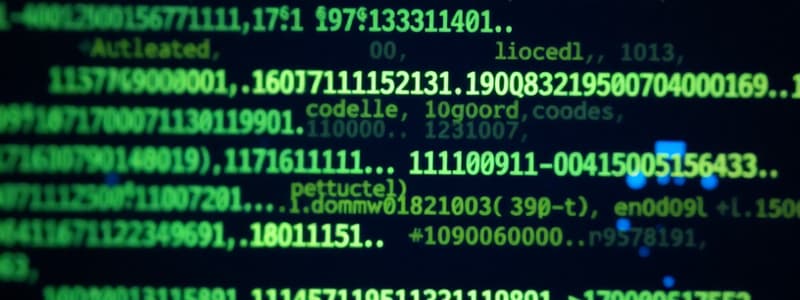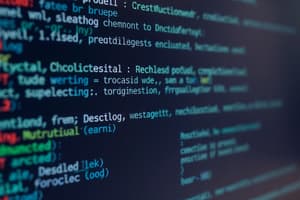Podcast
Questions and Answers
Which of the following are considered elements of communication?
Which of the following are considered elements of communication?
- Source or sender (correct)
- Message size
- Message encoding
- Channel or media (correct)
Protocols in communication are optional and do not affect the efficiency of the communication.
Protocols in communication are optional and do not affect the efficiency of the communication.
False (B)
What is meant by message encapsulation?
What is meant by message encapsulation?
Putting the message into a specific format or frame for transmission.
In network communications, the process of converting information into another acceptable form for transmission is called _______.
In network communications, the process of converting information into another acceptable form for transmission is called _______.
Match the following message delivery options with their definitions:
Match the following message delivery options with their definitions:
What happens to messages that are too long to be sent over the network?
What happens to messages that are too long to be sent over the network?
Message formatting is necessary only for human-readable formats.
Message formatting is necessary only for human-readable formats.
What role does flow control serve in network communication?
What role does flow control serve in network communication?
When a sending host encodes a message, the message is first converted into _______.
When a sending host encodes a message, the message is first converted into _______.
Which of the following statements is true regarding the reconstruction of messages?
Which of the following statements is true regarding the reconstruction of messages?
Which element is NOT one of the common elements of communication?
Which element is NOT one of the common elements of communication?
Protocols in communication are optional and do not have any effect on the communication process.
Protocols in communication are optional and do not have any effect on the communication process.
What is the process of converting information into bits for transmission called?
What is the process of converting information into bits for transmission called?
The practice of placing a message in an addressed envelope before sending it is known as _______.
The practice of placing a message in an addressed envelope before sending it is known as _______.
Match the following message delivery options with their definitions:
Match the following message delivery options with their definitions:
Which of the following is a function of flow control in network communication?
Which of the following is a function of flow control in network communication?
Message formatting is only necessary for human-readable formats.
Message formatting is only necessary for human-readable formats.
What happens to long messages before they are sent over a network?
What happens to long messages before they are sent over a network?
The _____ host receives and decodes the signals in order to interpret the message.
The _____ host receives and decodes the signals in order to interpret the message.
Which of the following is NOT a component of message timing protocols?
Which of the following is NOT a component of message timing protocols?
What is the primary role of protocols in communication?
What is the primary role of protocols in communication?
Message encapsulation is the process of identifying the sender and receiver of a message.
Message encapsulation is the process of identifying the sender and receiver of a message.
What is the process of converting a message into bits called?
What is the process of converting a message into bits called?
Each message is encapsulated in a frame before being sent over the network, which serves as an _______.
Each message is encapsulated in a frame before being sent over the network, which serves as an _______.
Match the following message delivery options with their definitions:
Match the following message delivery options with their definitions:
Which of the following is NOT part of message formatting?
Which of the following is NOT part of message formatting?
Flow control helps to prevent data loss by managing the timing of messages between source and destination.
Flow control helps to prevent data loss by managing the timing of messages between source and destination.
What must be done to a long message before it can travel across a network?
What must be done to a long message before it can travel across a network?
The _______ host receives and decodes the signals to interpret the message.
The _______ host receives and decodes the signals to interpret the message.
Which of the following describes message delivery options in network communications?
Which of the following describes message delivery options in network communications?
Flashcards are hidden until you start studying
Study Notes
Communication Methods
- All communication involves three main elements: Source (sender), Destination (receiver), and Channel (media).
- Protocols are essential for efficient communication, ensuring clarity and understanding between parties.
Importance of Protocols
- Effective communication requires defined protocols, which include:
- Identified sender and receiver
- Common language and grammar
- Speed and timing of message delivery
- Requirements for confirmation or acknowledgment
Network Communication Protocols
- Honeycomb of network protocols includes:
- Message Encoding: Transforming information into acceptable formats for transmission.
- Message Delivery Options:
- Unicast: One-to-one communication.
- Multicast: One-to-many communication.
- Broadcast: One-to-all communication.
- Message Formatting and Encapsulation: Identifying both sender and receiver.
- Message Timing: Manages access methods and flow control.
- Message Size: Long messages are broken down into smaller parts to meet size restrictions.
Message Encoding Process
- Information is transformed into bits by the sending host.
- Bits are encoded into patterns of sounds, light waves, or electrical impulses based on the network medium.
Message Delivery
- Destination host decodes incoming signals to interpret the message.
- Proper delivery requires standard formats for letters and addressing.
Encapsulation
- The process of enclosing a message in a specifically formatted frame before it is sent over a network.
- A frame functions like an envelope, providing both destination and source addresses.
Handling Long Messages
- Long messages must be segmented into smaller pieces, each sent in its own frame.
- Each frame carries individual addressing information, allowing for proper reassembly by the receiving host.
Access Method
- Indicates when hosts should start sending messages and how to manage collisions that occur during transmission.
Flow Control
- Negotiates timing between source and destination hosts to prevent overwhelming receivers and confirm information receipt.
Response Timeout
- Rules dictate how long hosts should wait for responses and specify actions if a response is not received in the expected timeframe.
Communication Methods
- All communication involves three main elements: Source (sender), Destination (receiver), and Channel (media).
- Protocols are essential for efficient communication, ensuring clarity and understanding between parties.
Importance of Protocols
- Effective communication requires defined protocols, which include:
- Identified sender and receiver
- Common language and grammar
- Speed and timing of message delivery
- Requirements for confirmation or acknowledgment
Network Communication Protocols
- Honeycomb of network protocols includes:
- Message Encoding: Transforming information into acceptable formats for transmission.
- Message Delivery Options:
- Unicast: One-to-one communication.
- Multicast: One-to-many communication.
- Broadcast: One-to-all communication.
- Message Formatting and Encapsulation: Identifying both sender and receiver.
- Message Timing: Manages access methods and flow control.
- Message Size: Long messages are broken down into smaller parts to meet size restrictions.
Message Encoding Process
- Information is transformed into bits by the sending host.
- Bits are encoded into patterns of sounds, light waves, or electrical impulses based on the network medium.
Message Delivery
- Destination host decodes incoming signals to interpret the message.
- Proper delivery requires standard formats for letters and addressing.
Encapsulation
- The process of enclosing a message in a specifically formatted frame before it is sent over a network.
- A frame functions like an envelope, providing both destination and source addresses.
Handling Long Messages
- Long messages must be segmented into smaller pieces, each sent in its own frame.
- Each frame carries individual addressing information, allowing for proper reassembly by the receiving host.
Access Method
- Indicates when hosts should start sending messages and how to manage collisions that occur during transmission.
Flow Control
- Negotiates timing between source and destination hosts to prevent overwhelming receivers and confirm information receipt.
Response Timeout
- Rules dictate how long hosts should wait for responses and specify actions if a response is not received in the expected timeframe.
Communication Elements
- All communication methods consist of three elements: source (sender), destination (receiver), and channel (media).
- Rules or protocols are essential for effective communication.
Importance of Protocols
- Protocols ensure communication effectiveness through:
- Clearly identified sender and receiver.
- Use of a common language and grammar.
- Defined speed and timing of message delivery.
- Requirements for confirmation or acknowledgment.
Network Communication Protocols
- Network protocols define several key aspects:
- Message Encoding: Converting information into a format suitable for transmission.
- Message Delivery Options: Includes Unicast (one-to-one), Multicast (one-to-many), and Broadcast (one-to-all).
- Message Formatting and Encapsulation: Identifying sender and receiver with specific formats.
- Message Timing: Involves access method and flow control strategies.
- Message Size: Limitations necessitate segmenting long messages into smaller parts.
Message Encoding
- Messages are initially transformed into bits by the sending host.
- Each bit can be encoded through sounds, light waves, or electrical impulses depending on the channel used.
Message Decoding and Encapsulation
- The receiving host decodes signals to interpret the original message.
- Proper addressing is critical for successful delivery, facilitated by encapsulation:
- Encapsulation involves placing the message into a specific format called a frame.
- A frame contains the destination and source addresses, acting as an envelope for the message.
Handling Long Messages
- Just as humans break messages into sentences, network messages are also segmented into smaller frames for travel.
- Each frame is addressed independently, allowing the receiving host to reconstruct the original message from multiple frames.
Access Method and Flow Control
- Access Method: Determines when hosts may send messages and manage potential collision responses.
- Flow Control: Coordinated by source and destination hosts to maintain optimal timing and avoid information overload.
Response Timeout Rules
- Hosts abide by specific rules on waiting for responses, defining actions that follow a response timeout for efficient communication.
Studying That Suits You
Use AI to generate personalized quizzes and flashcards to suit your learning preferences.




